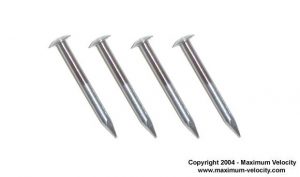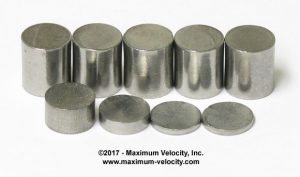If you’re wondering how to make a fast pinewood derby car for your next competition, the experts at Maximum Velocity have got you covered! From high quality derby car products, kits and car plans, we have the supplies and the know-how to craft a race-winning car every time.
How To Make a Fast Pinewood Derby Car
A lot of planning goes into making a fast pinewood derby car. Randy Davis, the expert behind Maximum Velocity, has a background in engineering and over two decades of experience in pinewood derby. Take some of his following recommendations into consideration when building your next car for competition:
Car Body
The basis of any competition car is the body. Typically, you can choose between a “standard” or an “extended” wheelbase for your car body. A standard wheelbase positions the car’s axles to the specifications set forth by the Cub Scout Pinewood Derby Kit. But an extended wheelbase puts the axles closer to the end of the block, providing more stability and performance. If allowed by your competition’s rules, use an extended wheelbase for a faster car.
Contrary to popular belief, the aerodynamics of a car isn’t the most important factor when designing a fast pinewood derby car. While a more aerodynamic car could prove beneficial in a close race, pay more attention to axles, wheels and weights if you’d like to ensure an edge above the competition.
Wheels & Axles
In general, grooved axles will outperform non-grooved axles. We believe this has less to do with a lube reservoir that can be stored in the grooves, but more so with minimizing the amount of contact between the wheel bore and axle shaft. Friction slows down your car, and minimizing contact minimizes friction.

The fastest axles in our inventory are the Pro Grooved Stainless Steel Axles (part 4052). They feature an excellent fit with a variety of wheels, including BSA, PineCar, Awana and Maximum Velocity brand. The two-step shaft also simplifies installation.
As far as wheels are concerned, typically lighter wheels are faster. This is because there is a certain amount of energy needed to start the pinewood derby car to roll when the starting pin drops. The lighter the wheels, the less energy is required to start rolling, so cars can get a jump at the starting line. Lighter wheels also allow the builder to focus more on the car’s weight distribution at a desired location, instead of spreading it around the car to compensate for heavier wheels.
Coning the wheel hub can also help you create a fast pinewood derby car. Coned hubs provide less contact with the car body, while instead focusing the contact more on the axle instead. This minimizes the braking that occurs when the wheel comes in contact with the car body. Most BSA wheels feature coned hubs. But for those that aren’t, we offer a Pro-Hub Tool.
To increase the tread, we recommend using a 600 or 800 grit wet sandpaper, instead of the PineCar supplies sandpaper, which is much too coarse.
Weights

For cars that feature less than one-half of the original block, lead or tungsten weight is required. For cars with very little wood, tungsten is needed to attain proper weight. Tungsten offers the highest density available, next to gold and other expensive metals. For cars that have the majority of the block remaining, a lighter, less dense weight works best, like steel or zinc.
Most competitions cap weight limits at 5 ounces. When adding weight, place it so that the final balance point of the car is 1 inch or less in front of the front axle. To achieve this, place 2/5 of the added weight behind the rear axle, and the remaining 3/5 in front of the rear axle.
Lubricants
In our testing, the best graphite for faster pinewood derby cars is high-purity flake with a medium to fine particle size. Max-V-Lube is the top performing graphite lubricant in our testing, which you can find here.
Molybdenum is a hard metal that some industrial processes use as a lubricant during processes with high heat and high pressure. None of these conditions are directly applicable to pinewood derby racing. In our testing, graphite with molybdenum did nothing to enhance performance of the cars, but it did end up scratching the axles that we spent so much time polishing.
If your competition rules only allow Dry White, we recommend using no lubricant at all. Dry White is a Teflon powder lubricant and performed very poorly during our tests.
Some people use common household items to lubricate their axles, like furniture polish, food oils, WD-40, etc. We have tested most of these products and found that although some of them work quite well, graphite was still superior.
Trust The Experts
If you are interested in learning more about how to make a fast pinewood derby car, check out Maximum Velocity’s detailed Car Plans, which come with designs for three proven award-winning cars. Or shop our impressive inventory of quality products to create a pinewood derby car that will smoke the competition. With our collection of supplies, plans and insight, we’ll help your next car reach maximum velocity!
